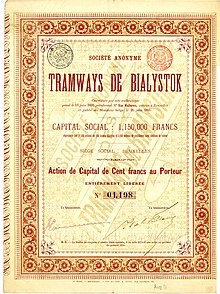Białystok tram
| Konka Bialystok | |
|---|---|
| Summer car at ul. Lipowa | |
| Basic information | |
| Country | Poland |
| city | Białystok |
| opening | 1895 |
| Shutdown | 1915 |
| Infrastructure | |
| Gauge | 1000 mm ( meter gauge ) |
| Power system | none (horse tram) |
| business | |
| Lines | 2 |
| vehicles | 23 summer cars 16 winter cars |
| Top speed | 13 km / h |
The Białystok tram was a horse-drawn tram in the Polish city of Białystok that existed from 1895 to 1915. Attempts to reintroduce tram operations in the city have so far failed.
history
In June 1893 the city government decided to introduce public transport with a horse-drawn tram modeled on the cities of Warsaw , Saint Petersburg and Paris . The construction of the tracks was awarded to Feldzer in 1893, who completed the work after two years, so that in 1895 the first horse-drawn trams for the transport of people and luggage could run. In summer, the railway operated 23 summer wagons without side walls, in winter 16 closed and heated winter wagons.
The financing was provided by the Belgian Société Anonyme des Tramways de Bialystok , which had a share capital of 115 million Belgian francs , subscribed in shares of 100 Belgian francs , which were traded in Brussels . The contract with the city stipulated that the tram would become the property of the city after 40 years of operation. This did not happen because the operation ended with the invasion of the German army in connection with the hostilities of the First World War in September 1915.
After the war, unsuccessful attempts were made in 1922 to set up an electric tram service, and the contract with a Belgian company that had already been signed was dissolved.
Considerations made in 2019 to introduce a 25 km long tram network with 45 stops failed due to funding.
stretch
The tram network consisted of two lines, which connected the station of the Petersburg-Warsaw railway with the Poleski station, today Białystok Fabryczny. The following description uses today's street names. Both routes began at Białystok station, ran through today's Kolejowa, crossed the Petersburg-Warsaw railway with an iron arch bridge, followed the Lipowa and Rynek Kościuszki, where the lines divided. One followed the Sienkiewicza to its end at Białystok Fabryczny, the other led via Kilińskiego – Pałacowa – Warszawska – Świętojańska into the recreational area of the Zwierzynieckie forest. The tram depot was located on Świętojańska, between Skłodowska and Akademicka, near what is now the Białystok Voivodeship Hospital .
Individual evidence
- ↑ a b Krótka historia komunikacji miejskiej w Białymstoku. In: fotopolska.eu. Accessed January 2, 2020 .
- ↑ a b Alicja Zielinska: Konka. Po Białymstoku też jeździły tramwaje. In: Courier Poranny. August 30, 2016 (Polish).
- ↑ Andrzej Lechowski dyrektor Muzeum Podlaskiego w Białymstoku: Tramwaje w Białymstoku. October 13, 2013, accessed December 30, 2019 (Polish).
- ↑ Redakcja: Czy w Białymstoku będą tramwaje? Zobacz line tramwajowe. March 12, 2019, accessed December 30, 2019 (Polish).

